Good zone lighting
Zone lighting provides large amounts of light where it is needed for specific activities, e.g. reading, eating or working. At the same time, it creates exciting lighting accents which are as important for harmony within a room as uniform ambient lighting. Zone light is produced by luminaires that direct their light downwards or against the wall. The more flexible the focus of the luminaire, the easier it is to direct the light precisely to where it is required. If a dining table is lit by ambient light alone, the resulting atmosphere is similar to that found in an industrial kitchen. Zone lighting on the other hand creates the pleasant atmosphere of family meals.

Zone lighting for armchairs and sofas
Ideal luminaires for armchairs and sofas emit direct zone lighting which illuminates the reading area while being glare-free. For this purpose, it is recommended to use a floor lamp or a table lamp. Some floor lamps save space by combining zoned reading light with ambient lighting which is directed at the living room ceiling. It is advantageous if the light can be controlled while you are still sitting and if it is equipped with a dimmer, which can be used to adapt the light intensity to suit different situations. Some table lamps supply a homely light, turning the central area of the living room into a pleasant island of light. However, such light is not always suitable if you wish to read for a longer period of time. Those who read a lot or spend their time on other activities involving a lot of concentration, should choose a zone light that sufficiently illuminates the reading area. Flexibly adjustable lamps which can be moved to focus their light directly onto the reading area are ideal for such purposes. If a table lamp is used to provide zone lighting for sofas and armchairs, it must not be possible to look directly at the illuminant in order to avoid glare. This means that a table lamp must be positioned at a suitable height or its lampshade must prevent any glare. This can be guaranteed by the light source being covered from above or by the lampshade being tapered inwards towards the top.
Zone lighting for armchairs and sofas

Zone lighting for coffee tables
Illuminating coffee tables produces an unusual and thus highly interesting effect. When providing zone lighting for coffee tables, it is recommended to make use of ceiling lights which produce little glare and have a narrow beam of light which only illuminates the table and not the area around it. This means that the light is concentrated onto the table and the extraordinary lighting effect is intensified. If no ceiling outlet is available over the coffee table, it is recommended to use floor lamps with a flexibly adjustable light. Arc lamps with a far reaching arm also present a good alternative.
Zone lighting for coffee tables
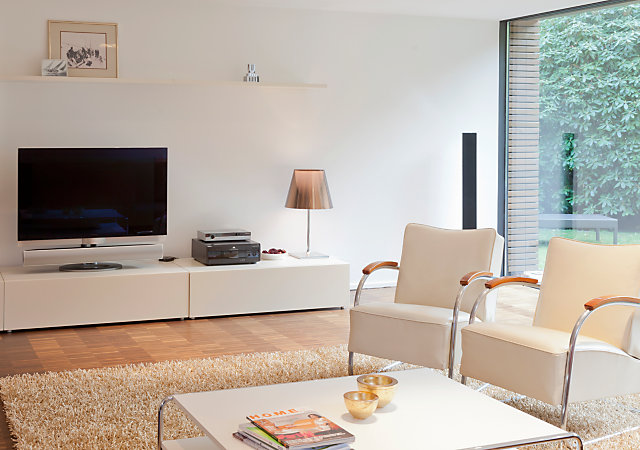
Zone lighting for televisions
Watching television in a completely dark room tires your eyes out very quickly. For this reason, it is recommended to illuminate the area around the television using low-wattage bulbs which emit weak light. This light should be glare-free and should not reflect off the television screen. A suitable table lamp or furniture lamp with a clamp can be positioned next to or, ideally, behind the television.
Zone lighting for televisions
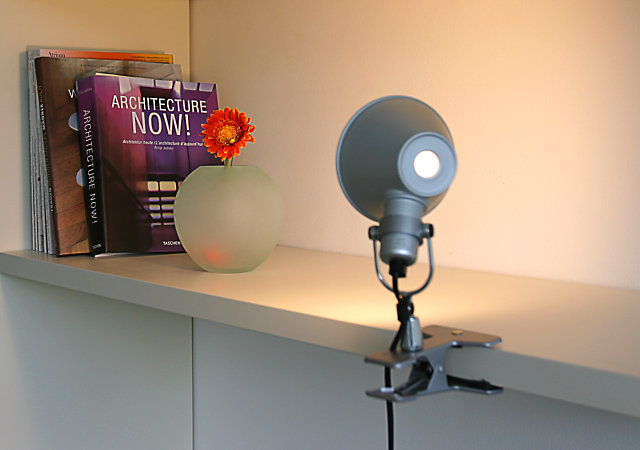
Zone lighting for cupboards and shelves
There are two good reasons to illuminate cupboards and shelves. Firstly, proper illumination makes chinaware, glasses, books or clothing easier to see and consequently quicker to find. Secondly, it creates a special atmosphere by putting attractive cupboards and shelves as well as their content in the limelight. The following types of luminaires are generally available for the illumination of cupboards and shelves: ceiling lights which make suitable wallwashers, track systems, clip-on lights and surface-mounted furniture lights. The distance between the ceiling light and the cupboard or shelf should be set so that the piece of furniture is illuminated from top to bottom and no shadows are cast by the person standing in front of it. For average ceilings with a height between 2.5 and 3 metres, the distance should be between 50 and 80 centimetres.
Zone lighting for cupboards and shelves
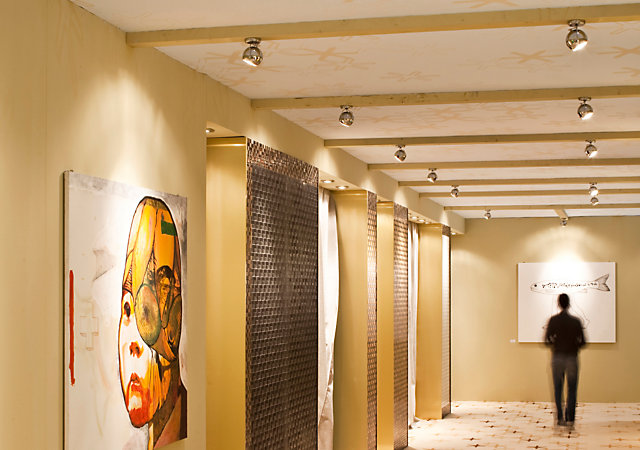
Zone lighting for paintings and pictures
Your eyes preferably concentrate on bright areas. Paintings and pictures attract far more attention when they are illuminated. Illuminants with an excellent colour rendering such as incandescent lamps and halogen lamps make paintings and pictures seem especially colourful and natural. Attention must be paid when using classic picture luminaires which are positioned above paintings or pictures. Here, not all models provide for a uniform illumination of the picture. Furthermore, some illuminants produce heat that might damage the picture. When selecting a respective light it is important to get an idea of the lighting quality and it must be observed which illuminant is to be used. Alternatively, it is recommended to use ceiling lights and track systems which allow you to focus the light directly towards the painting or picture. Moreover, ceiling lights which serve as wallwashers and provide an even illumination of the walls and pictures are also suitable. The distance between the luminaire and the picture should be set to ensure that the light is not reflected by the glass of the frame and that the beam of light falls onto the picture at an angle of 45 degrees or at an even steeper angle. For average ceilings with a height between 2.5 and 3 metres, the distance should be between 50 and 80 centimetres.
Zone lighting for paintings and pictures
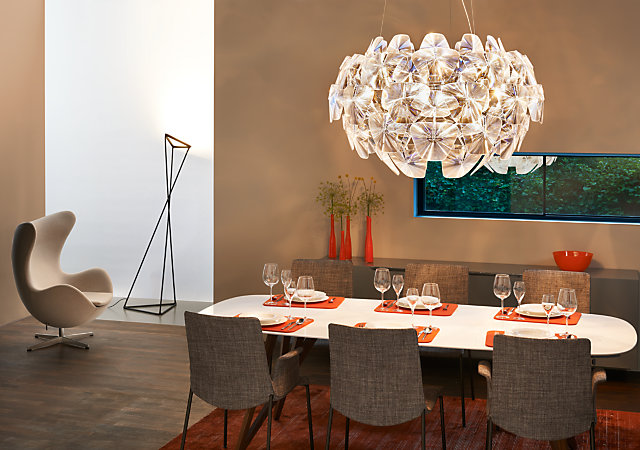
Zone lighting for dining tables
Pendant lights are particularly well suited for a focused illumination of the dining table and they additionally might be a decorative feature within the room. Alternatively, ceiling lights with a highly focussed beam of light can be used. The main aim is to brightly illuminate the tabletop while emitting subdued diffused light onto the people around the table. Thus, the light emitted by the luminaire should only directly illuminate the tabletop and not the surrounding area. The light reflected by the tabletop is sufficient to flatter the people's faces and to make the facial expressions look vivid. For an excellent colour rendering it is recommended to make use of luminaires equipped with incandescent lamps or halogen lamps. Such luminaires also give a particular intensity to the natural colours of wooden tables. Dining table lights must not obscure people or produce glare. Depending on the type of the luminaire, pendant lights should therefore be suspended above the table at a distance between 50 and 80 cm. As dining tables are usually used for a variety of applications, a dimmer is recommended, which can be used to adapt the light intensity to suit your personal requirements. Round pendant lights with a maximum wattage of 150 watts or even specific ceiling lights with a highly focused, round beam of light are suitable for illuminating round tables. Pendant lights are also suitable for illuminating square and rectangular tables, as are highly focused ceiling lights. If the table is extremely long, instead of using just one large luminaire, several smaller luminaires can be arranged next to one another. Flexible workplace lights which can be attached to the wall or the edge of the table can be used to illuminate small tables in confined spaces. When they are not in use, the luminaires can be folded away to save space. If the dining table is not positioned under the ceiling outlet, we recommend the use of ceiling luminaires which have a flexible arm and can therefore be directed to where the light is required. Large floor lamps are even more flexible as their far reaching arms can stretch out and completely illuminate tables with a length of up to 160 cm.
Zone lighting for dining tables
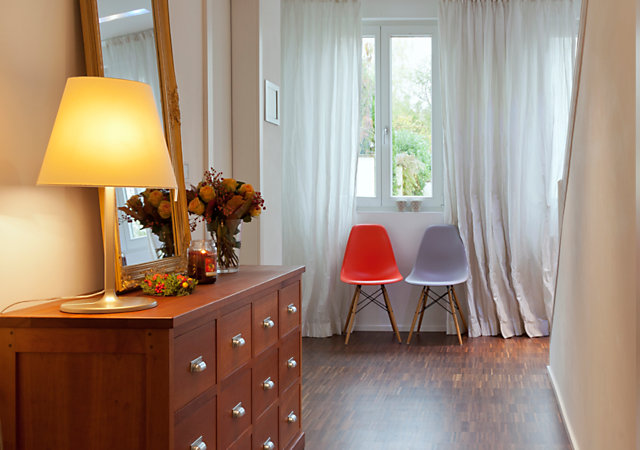
Zone lighting for sideboards and commodes
Sideboards and commodes are usually used frequently. On the one hand, they are used as a storage place for everyday items such as keys, wallets or mobile phones. On the other hand, they are also used as a storage area for a number of things that we use regularly. Good illumination facilitates the use of sideboards & commodes since it allows you to easier and faster find the things you are looking for. In addition, sideboards and commodes are used to place decorative items and framed photographs of loved ones. Such items really do deserve to be properly illuminated. When choosing a suitable lighting solution for sideboards and commodes, a small, subtle difference plays an important role: in the case of a commode, the drawers are pulled out forwards, while the compartments in sideboards remain in a stationary position on top of each other. To brightly illuminate both the top and the drawers, we recommend luminaires which are directed downwards onto the piece of furniture. Ceiling lights with narrow beams of light, which fall vertically onto the commode, are ideal. The light for sideboards, on the other hand, is better to shine diagonally downwards as this optimally illuminates both the top and the compartments. The ideal solution is presented by ceiling lights with narrow beams of light which are obliquely directed at the sideboard and are positioned a short distance away from the sideboard rather than directly above it. The distance between the ceiling light and the sideboard should be set to ensure that no shadows are cast by the person standing in front of it. For average ceilings with a height between 2.5 and 3 metres, the distance to the wall should be between 80 and 120 centimetres. When using ceiling lights to create zone lighting for sideboards and commodes, track systems can be useful as they allow you to flexibly arrange the lights within the room, regardless of where the ceiling outlet is located. Table lamps are also often the top choice when illuminating sideboards and commodes. They can be highly decorative and can emphasise a homely atmosphere. However, they rarely illuminate the entire surface of the furniture and the direct illumination of the drawers and compartments is often insufficient. A table lamp is therefore only recommended for illuminating sideboards and commodes if the surfaces, drawers and compartments are not used on a daily basis. If a table lamp is used, it must not be possible to look directly at the illuminant in order to avoid glare. This means that a table lamp must be positioned at a suitable height or its lampshade must prevent any glare. This can be guaranteed by the light source being covered from above or by the lampshade being tapered inwards.
Zone lighting for sideboards and commodes
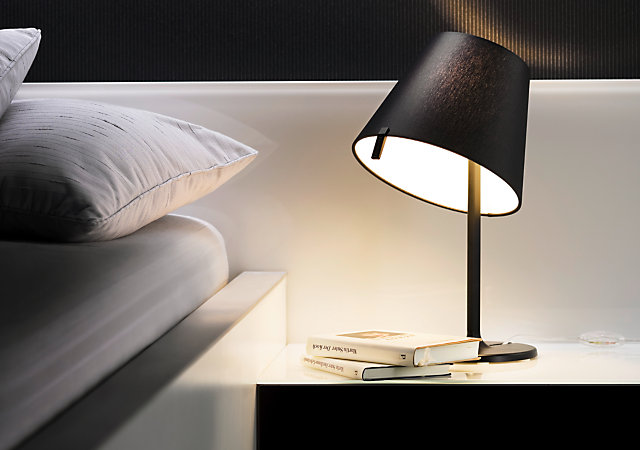
Zone lighting for beds
People looking for bedside table lamps rarely want to illuminate the bedside table itself, but they rather want to create a good reading light for when they are in bed. The zone light must therefore be directed at the reading area of the bed and be sufficiently bright while also being glare-free. Flexibly adjustable table lamps, floor lamps and wall lights are ideally suited for this purpose as the light can be individually adjusted. It is recommended to use lights equipped with a bulb with a power rating between 40 and 60 watts. If a table lamp is used, it must not be possible to look directly at the illuminant in order to avoid glare. This means that a table lamp must be positioned at a suitable height or its lampshade must prevent any glare. This can be guaranteed by the light source being covered from above or by the lampshade being tapered inwards towards the top. The reading lamp can be positioned on either side of the bed. With double beds it is possible to install the luminaires centrally above the bed so that the light is directed outwards. This reduces the risk of one partner being blinded by the other's light.
Zone lighting for beds

Zone lighting for desks
Table lamps, wall lights, floor lamps and pendant lights are all suitable for creating zone lighting for desks. They should illuminate your work station evenly, ideally from one side. Right-handed people position the light source on their left, while left-handed people position it on their right. This prevents their hands from casting annoying shadows onto their work. For an excellent colour rendering of items on the table, it is recommended to use luminaires with incandescent lamps or halogen lamps. Such luminaires also give a particular intensity to the natural colours of wooden tables. The more flexibly a desk lamp can be positioned, the better the light can be focused onto particular areas of the table as required. The light can also be intensified for detailed tasks. If you want to save space on your desk, pendant lights, floor lamps and desk lamps which can be attached to the wall above your desk are ideal. A special tip: particularly in a study, such luminaires are suitable which combine zone lighting for your desk with indirect ambient lighting.
Zone lighting for desks
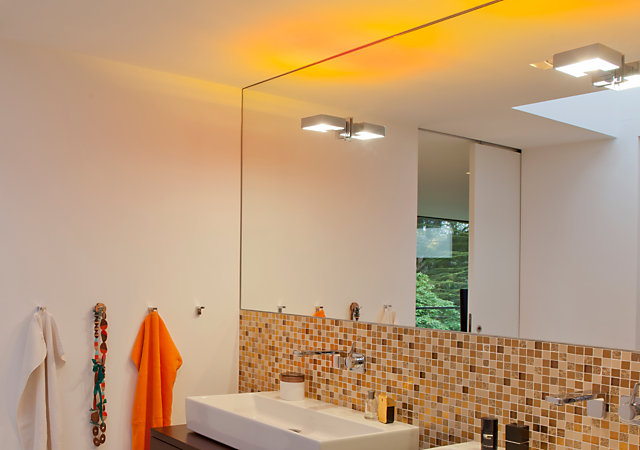
Zone lighting for mirrors
The ideal light for mirrors is extremely bright, soft and warm. It should be emitted evenly and, where possible, from all directions. It should also be glare-free on faces and bodies. The reflections in the mirror are therefore complimentary, flattering and free from annoying shadows. Faces can be properly illuminated by positioning the mirror lights on either side of the mirror. In confined spaces such as guest toilets or small hallways, the luminaires can also be positioned above the mirror. For intensive facial care and the application of cosmetics, mirror lighting which illuminates your face from all directions is ideal. For this purpose, special mirrors with an integrated illumination system are available. An attractive additional feature for your bathroom is an illuminated cosmetic mirror with a magnifying function. It flanks the mirror above the sink and facilitates intensive facial care and a smooth shave. As a pleasant contrast to the soft, scattered, low shadow zone lighting around the mirror, it is recommended to make use of direct ambient lighting. Usually, ambient lighting is diffuse and zone lighting is direct. When used to illuminate mirrors, however, this should be just the reverse.
Zone lighting for mirrors
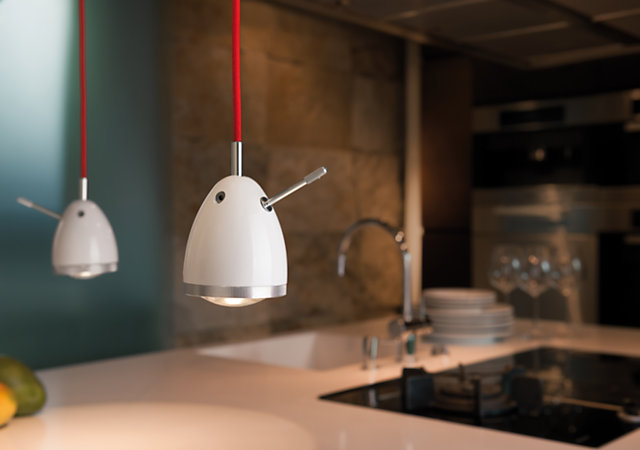
Zone lighting for kitchen worktops
For kitchen worktops, a particularly sophisticated illumination is required – after all, you do not want to get hurt when working with sharp knives. For a zoned lighting the following luminaires are generally suitable: highly focused ceiling lights, track systems, adjustable wall lights, surface-mounted furniture lights and clip-on lights. The important thing is that the light does not come from behind and cast the people's shadows onto the worktops while they are working in the kitchen. If wall units or shelves are present, furniture luminaires with fluorescent lamps or halogen lamps can be positioned under the front edge of the wall unit. Fluorescent lamps evenly illuminate large surfaces while the light produced by halogen lamps is more lively and atmospheric. If you have a worktop without wall units and shelves, you can use ceiling lights and track systems to produce highly focused light that is directed onto the worktop. Track systems have the advantage that numerous luminaires can be flexibly positioned regardless of the location of the ceiling outlet. Alternatively, wall lights with far reaching arms can be used for the illumination of the worktop. The more flexible the positioning of the luminaire, the easier it is to direct the light to where it is required. If a wall shelf is located above the worktop, clip-on lights are a quick and flexible solution to create zone lighting for the worktop.
Zone lighting for kitchen worktops










